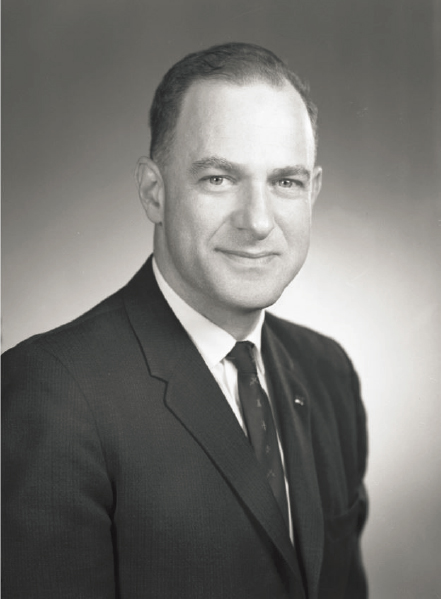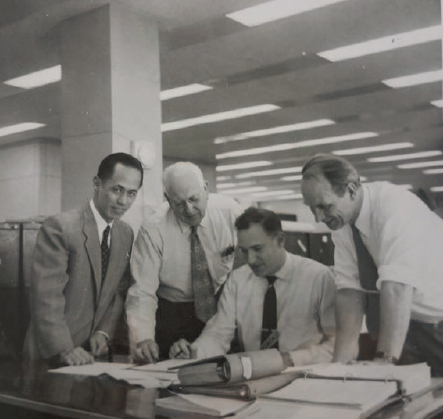

RALPH S. GENS
1924–2019
Elected in 1983
“Contributions to the advancement of electric power transmission technology through creative engineering accomplishments and management leadership of research and development.”
BY CARSON W. TAYLOR
RALPH SAMUEL GENS, who led the Bonneville Power Administration’s development of the Pacific Northwest 500 kV transmission grid with California interties and the introduction of high-voltage direct current in the United States with the Pacific Northwest–Pacific Southwest DC intertie, died at age 94 on January 3, 2019, in Kailua-Kona, Hawaii. His many contributions to the advancement of electric transmission technology—sound, progressive engineering and innovations and refinements—had a profound effect on the industry on a national and international scale.
Born in Berlin, Germany, on November 25, 1924, Ralph came to live in Portland, Oregon, in 1939 at age 14, via Kindertransport. He told of standing on the street with his father, a decorated World War I veteran, watching Hitler pass. In Portland Ralph lived with his aunt and uncle, Edna and Richard Genserowski (a 1902 Olympic gymnast), both leaders in Portland’s German community. His Washington High School class awarded him a scholarship to Oregon State University, but he could not use it at the time as the campus was too near the Pacific Coast—German nationals were not
___________________
Much of the information for this tribute was provided by Ralph Gens’ daughter, Marilyn Gens Johnson.
allowed within many miles of the ocean. Drafted while a student at the University of Washington, Ralph became a US citizen while in basic training and served in the Pacific as a scout in the US Army Infantry (1943–46), ending his service in Japan after its surrender.
In 1949 he earned a BS in electrical engineering from Oregon State College (now Oregon State University, OSU), where Eugene Starr (NAE 1977) became his mentor and steered him toward the Bonneville Power Administration in Portland during his senior year. Ralph began his BPA career as an engineering aide in the System Engineering Branch, then became chief of the branch in 1966.
Ralph’s work included insulation coordination, high-voltage practices, planning and economic analyses, and R&D. He was particularly interested in high-voltage phenomena, in terms of insulation coordination and the application of new concepts to reduce insulation requirements to make higher-transmission voltage more attractive. He had considerable influence on high-voltage technology, and his early work refining control of high-voltage insulation became widely used throughout the world.
Later he guided the development of BPA’s 500 kV transmission network, at the time the largest in the world, and provided the motivation and expertise that led to acceptance of high-voltage direct current (HVDC) transmission in the United States. Eventually he guided the world’s first three-phase 1100 kV transmission line for test and demonstration purposes. Other innovations that came about under his direction included improved switching surge controls, insulation levels, series capacitors, large braking resistors, high-speed circuit breakers, staged system tests, advanced system computer programs, computer-aided design, and greatly reduced electrical losses on transmission lines.
It was as a direct result of Ralph’s suggestions that BPA established the first HVDC test facility in the United States, at the Big Eddy Substation above The Dalles, Oregon. He recruited talented expertise from within BPA and around the world, bringing in engineers from Sweden, India, Germany,
and the United Kingdom (the three that became US citizens were later elected to the NAE1). Ralph’s own expertise enabled him to evaluate technical proposals for the facilities required for the Pacific Northwest–Pacific Southwest DC Intertie from the Columbia River to Los Angeles, and then solidify the negotiations between government agencies, electric utilities, and manufacturers to create a most successful pioneer long-distance project.
In 1974 he became manager of planning and research, and in 1977 was appointed BPA assistant administrator, engineering and construction (chief engineer), a position he held until his retirement in 1980, after which his consulting activities took him to the jungles of Papua New Guinea and South America. For 10 years Ralph was a technical and management consultant for the Papua New Guinea Electricity Commission, mentoring young nationals to assume senior civil service positions while advising on the construction of the transmission system connecting the new Yonki Dam to Port Moresby.
At BPA he was a dynamic, innovative, and demanding chief engineer. RWI became a favorite expression of his engineers—Ralph Wants It. As an example, he wanted to promote Bill Tinney (NAE 1998) to GS-15, but his higher-up manager would not approve the promotion—Ralph did it while the manager was on vacation. His management ability and unconventional style inspired high performance while bringing together engineering personnel with diverse talents. Always supportive of engineering excellence, one of his initiatives was the establishment of a technical career advancement path for engineers, parallel to management paths, that was helpful to many (including this writer).
Ralph credited the BPA librarian, Erik Bromberg, with fostering his curiosity in what was happening around the world in the specific engineering areas he was already focusing on early in his career. This librarian had the new idea of ordering technical periodicals that could communicate the newest technical activities—especially research, which led to Ralph’s reading
___________________
1 Stig Annestrand, Narain Hingorani, and John Vithayathil
about HVDC applications around the world long before there were any in the United States. Vision and enthusiasm throughout his career were fueled by the international experience.
Ralph Gens held a patent and authored more than 20 technical publications, several of which were considered benchmarks in his field. In addition to his work at BPA, his research interests involved him as coordinator of Project EHV/UHV. He was also invited or elected to serve in several leadership positions: as US vice president and US national advisor for CIGRÉ (International Council on Large Electric Systems; 1979–80), chair of the IEEE Surge Protection Devices Committee and later the CIGRÉ Study Committee on System Analyses and Techniques, and chair of the Department of Energy’s Energy Research Advisory Board (1984–85).
Beginning in 1972 Ralph was selected as a member of the Joint US-USSR Coordinating Committee on Scientific and Technical Cooperation in the Field of Energy; he headed delegations to the USSR in both 1976 and 1978, and in 1978 the delegation at the US meetings. He was the National Science Foundation project advisor for an electrical energy project in Yugoslavia, and served in an official US delegation to the People’s Republic of China assisting that country in developing hydroelectric resources and transmission facilities.
His many honors included recognition as a fellow of the Institute of Electrical and Electronics Engineers (1969), Meritorious and Distinguished Service Awards from the Department of the Interior (1973 and 1978), election to the NAE (1983), the IEEE Habirshaw Award and Centennial Award (both in 1984), election to the OSU Engineering Hall of Fame (1999), the IEEE Medal for Engineering Excellence (2003), and the CIGRÉ Philip Sporn Award (2018).
Quoting from one of his award recommendations: “Mr. Gens is a truly outstanding public servant. He has given his time and talents in full measure and is respected within and outside BPA for his industry, resourcefulness, dedication, and loyalty to the government. The tremendous amount of drive which he exhibited throughout his working life has not been motivated by any desire for personal recognition, for Mr. Gens
is one of those modest and unassuming successful men. As a public servant, he is one of the best.”
In 1951 he met Ida Mattson on a bus going to work, before he realized that they worked in the same office at BPA. They married the following year and Ida provided encouragement as well as professional and domestic support throughout his career.
Ralph’s proudest legacy was the family he and Ida created. The impacts of his experience as a teen refugee and the loss of most of his extended family in the Holocaust instilled a deep desire to foster meaningful relationships and honor his extended family. He traveled the world with Ida, their children Marilyn and David, and grandchildren, introducing them to their cousins and leaving them with a close and loving global family. He instilled values of loyalty to family, work, education, and humanity.
In retirement he, Ida, and their son David built a home at Mt. Hood, OR, and “The Cabin” became a place for summer reunions with far-flung family, reconnecting and enjoying hikes in the forest and fields. Into his 90s, Ralph enjoyed chainsaw work, walking the property line, and directing his grandchildren on how to build a proper bonfire. He would claim that his most significant retirement project was encouraging and supporting all five of his grandchildren to their university degrees.
At Ida’s request they retired to Kona in 1987. There, even at age 94, Ralph swam regularly in Kahalu‘u Bay. He followed world affairs, played bridge, tended the yard, and engineered his solar array. This solar energy project required him to get his professional engineering license from the state of Hawaii. When asked to provide contact information for the licensed professional engineers that supervised his work, a routine question, he had to respond that there were none still living.
For many, including his family, Ralph Gens was larger than life. The respected patriarch of an extended family that spanned continents, he was intellectual, elegant, generous, loyal, and accomplished. He is remembered fondly by his family, friends, and colleagues around the world.






